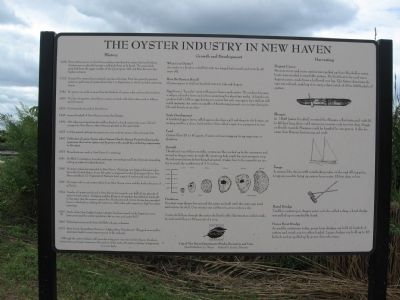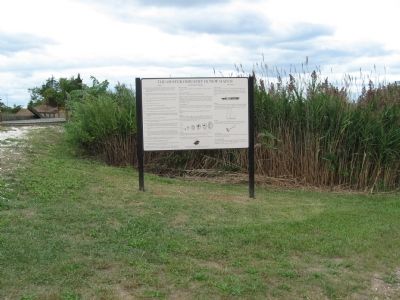East Shore in New Haven in New Haven County, Connecticut — The American Northeast (New England)
The Oyster Industry in New Haven
History
1762 Demand for oysters has increased, causing a shortage. First law passed to protect oyster, no gathering of oysters from May 1 to September 1, which includes spawning season.
1784 No person can pick up more than two bushels of oysters a day and must be resident.
1800 The law is forgotten. New Haven carries on trade with other cities such as Albany and Montreal.
1815 First steamboats used in New Haven.
1848 James Goodsell of New Haven invents the Sharpie. 1850 250 schooners importing two million bushels of seed oysters (two years old and younger) to New Haven, where they are planted in the oyster beds.
1855 Lot law passed, stating one person can own only two acres or less of oyster lots.
1867 Cultivation of oysters begins when Captain Charles Henry Townsend persuades oystermen that native oysters can be grown with a profit by conducting experiments in this moat.
1873 Steamboats are used in New Haven for oystering.
1881 Shellfish Commission founded and maps out underground lots of private ownership, setting up stakes for identification.
1900 No more oysters are imported to New Haven. Oystering now biggest fisheries industry in the United States. Some 50 oyster companies line the Quinnipiac River. New Haven produces 12 1/2 percent of Nation's total output of oysters and seed oysters.
1910 No longer safe to eat oysters taken from New Haven rivers and the harbor because of pollution.
1924 Number of oysters produced in New Haven decreases to one-half of one percent of nation's total output. Dredging and the filling in of marshes has added so much silt to the water that the oysters cannot live. Hurricanes and winter storms have wreaked havoc in the harbor, making the water too cold or the salt content too high for oyster spawning.
1950 Much of the New England oyster industry has been wiped out by hepatitus scares, hurricanes and the oyster's predators, the sea star and oyster drill.
1965 Federal government declares shellfish industry a disaster.
1972 State forms Aquculture Division of Agriculture Department. This, and more public awareness leads to some improvement in the industry.
Although the oyster industry will never be as big as it once was in New Haven, thanks to stricter laws and improvements in the quality of the water, the oyster industry is beginning to come back.
An oyster is a bivalve, a shellfish with two hinged halves and can live to be 40 years old.
How Do Oysters Breed?
Oysters spawn in shallow, brackish water in July and August.
Eggs from a "brooder" meet with sperm froma a male oyster. The embryo becomes a veliger, a bivalve larva and is free-swimming for about two weeks. A female can produce half a billion eggs during one season but only one egg in four million will reach maturity. An oyster is capable of functioning as a male at one tome during its life and female at another.
Early Development
A fertilized egg or larva, called spawn, develops a gill and drops to the bottom, attaching itself to a clean, hard surface. Now called a spat, it is a pinpoint in size.
Food
Oysters filter 20 to 30 quarts of water an hour, trapping living organisms or plankton.
Growth
Thumbnail size at three months, oysters are then picked up by the oystermen and moved to deeper water to make the spawning beds ready for next summer's crop. Moved several times before being harvested, it takes four to five years for an oyster to reach the market size of 3 ½ inches.
Predators
Sea stars wrap themselves around the oyster and pull until the oyster gets tired and relaxes its shell. One sea star can eat three to seven oysters a day.
Oyster drills bore through the oyster shell with a file-like structure called a radula, and can kill up to 60 percent of a crop.
Because more and more oysters were picked up from the shallow water, boats were needed to reach the oysters. The first boat to be used was a dugout canoe, made from a hollowed-out log. The Native Americans design was refined, enabling it to carry a day's catch of 30 to 100 bushels of oysters.
Sharpie
In 1848 James Goodsell invented the Sharpie, a flat-bottomed craft 20 to 40 feet long, that could manuever in water only two feet deep. Single or double masted, Sharpies could be handled by one person. It also became New Haven's first racing sail craft.
Tongs
A scissor-like device with interlocking rakes on the end of long poles, tongs are used to bring up oysters from water 15 feet deep or less.
Hand Dredge
Used for oystering in deeper water and also called a drag, a hand dredge was pulled up or cranked by hand.
Power Boat Dredge
As used by oystermen today, power boat dredges can hold 21 bushels of oysters and weigh one ton when loaded. Larger dredges can hold up to 20 bushels and are pulled up by power driven hoisters.
John DeStefano, Jr., Mayor • Robert D. Levine, Director
Erected by City of New Haven Department of Parks, Recreation and Trees.
Topics. This historical marker is listed in this topic list: Industry & Commerce. A significant historical month for this entry is May 1755.
Location. 41° 16.261′ N, 72° 54.231′ W. Marker is in New Haven, Connecticut, in New Haven County. It is in East Shore. Marker can be reached from the intersection of Woodward Avenue and Pope Street, on the right when traveling south. Located in Black Rock Fort. Touch for map. Marker is in this post office area: East Haven CT 06512, United States of America. Touch for directions.
Other nearby markers. At least 8 other markers are within walking distance of this marker. Society of The Cincinnati Memorial (within shouting distance of this marker); In Honor of Captain Nathan Hale (within shouting distance of this marker); Black Rock Fort (about 500 feet away, measured in a direct line); Patriots of New Haven Memorial (about 500 feet away); Fort Nathan Hale (approx. 0.2 miles away); East Shore Park (approx. 0.6 miles away); In Memory of George Pardee (approx. 0.6 miles away); Roll of Honor (approx. 0.8 miles away). Touch for a list and map of all markers in New Haven.
Credits. This page was last revised on February 10, 2023. It was originally submitted on September 14, 2010, by Michael Herrick of Southbury, Connecticut. This page has been viewed 1,723 times since then and 140 times this year. Photos: 1, 2. submitted on September 14, 2010, by Michael Herrick of Southbury, Connecticut.

